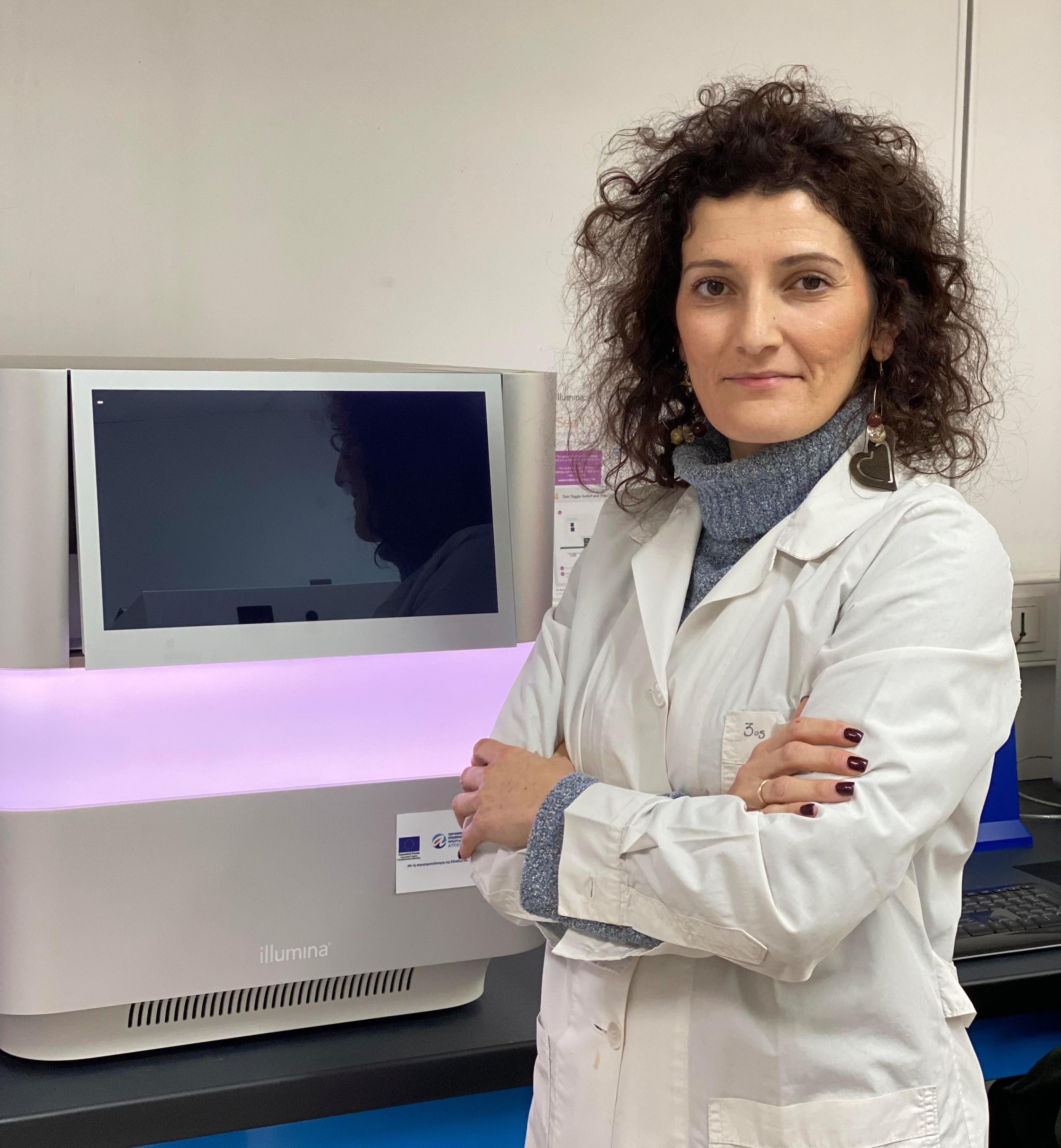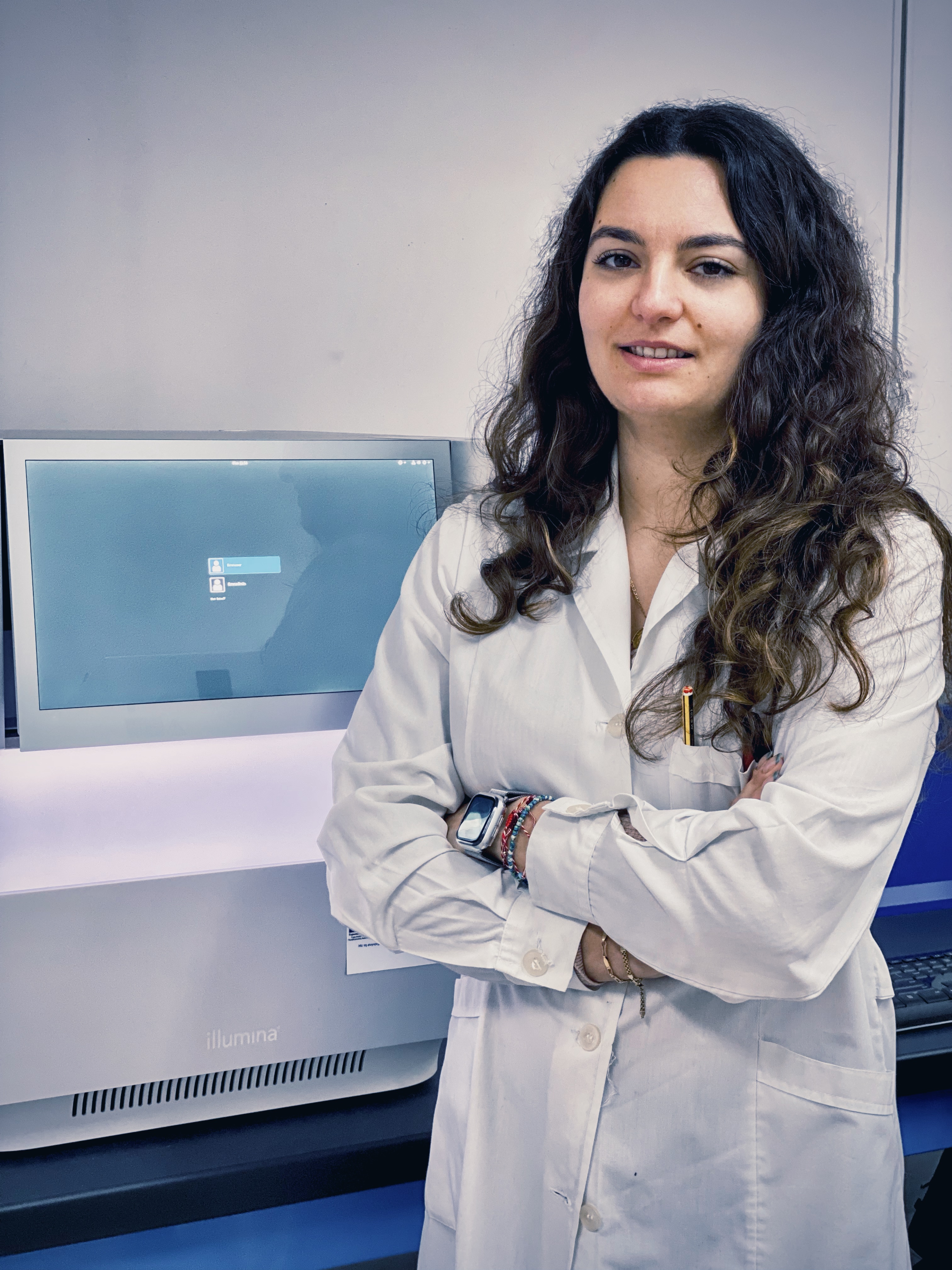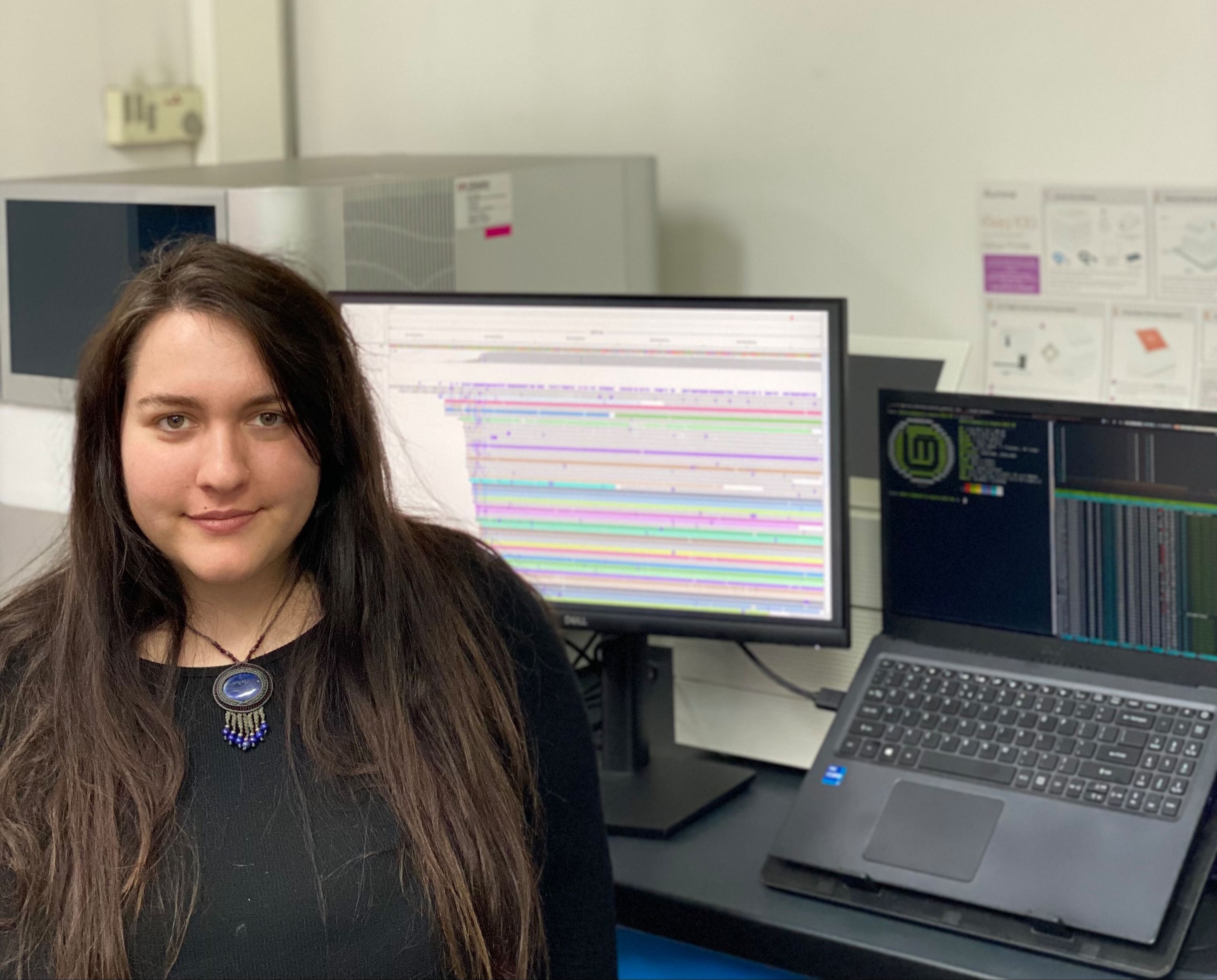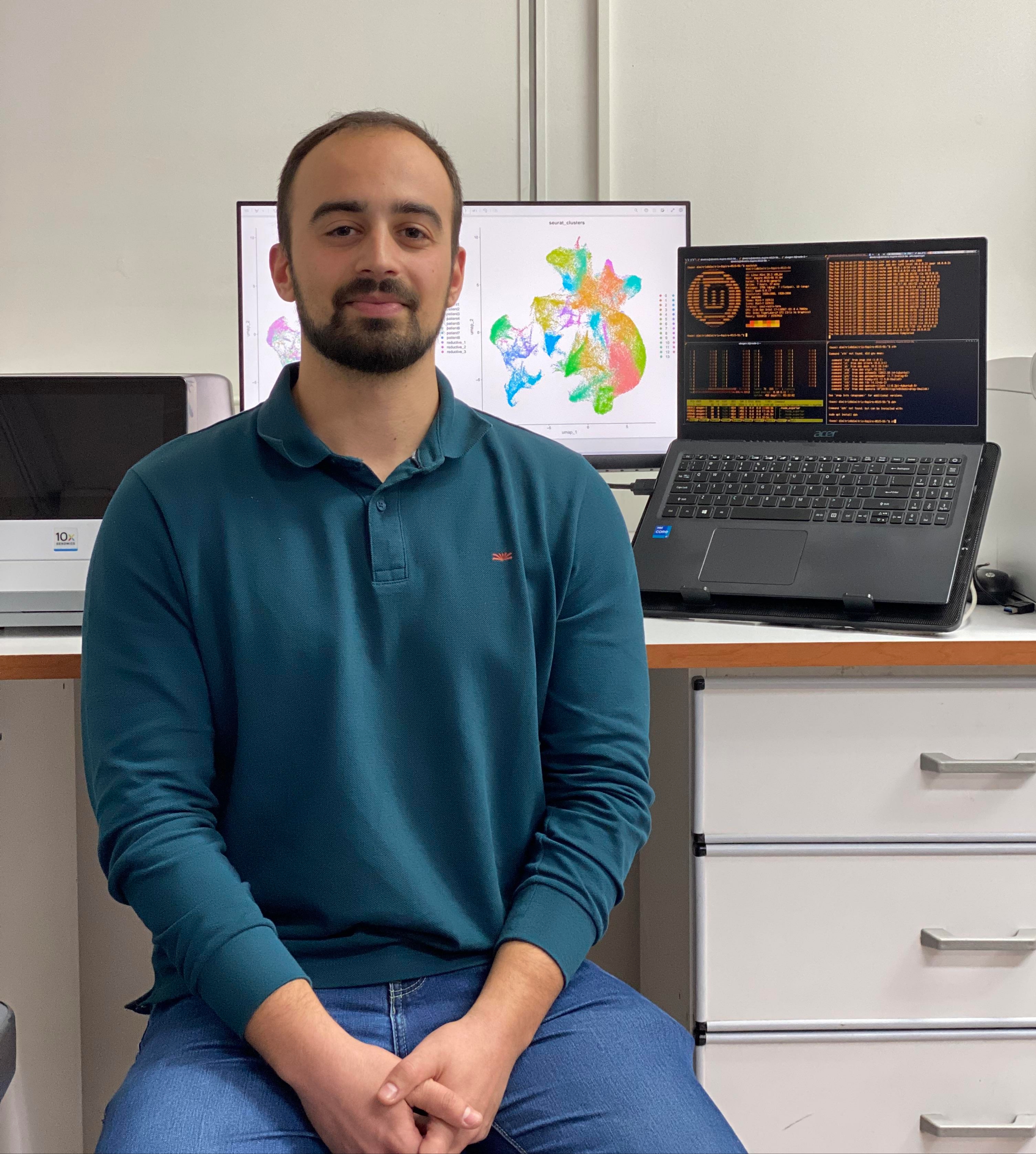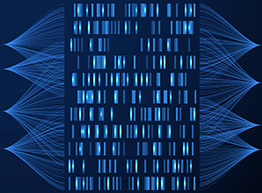

Dr
Karamitros Timokratis
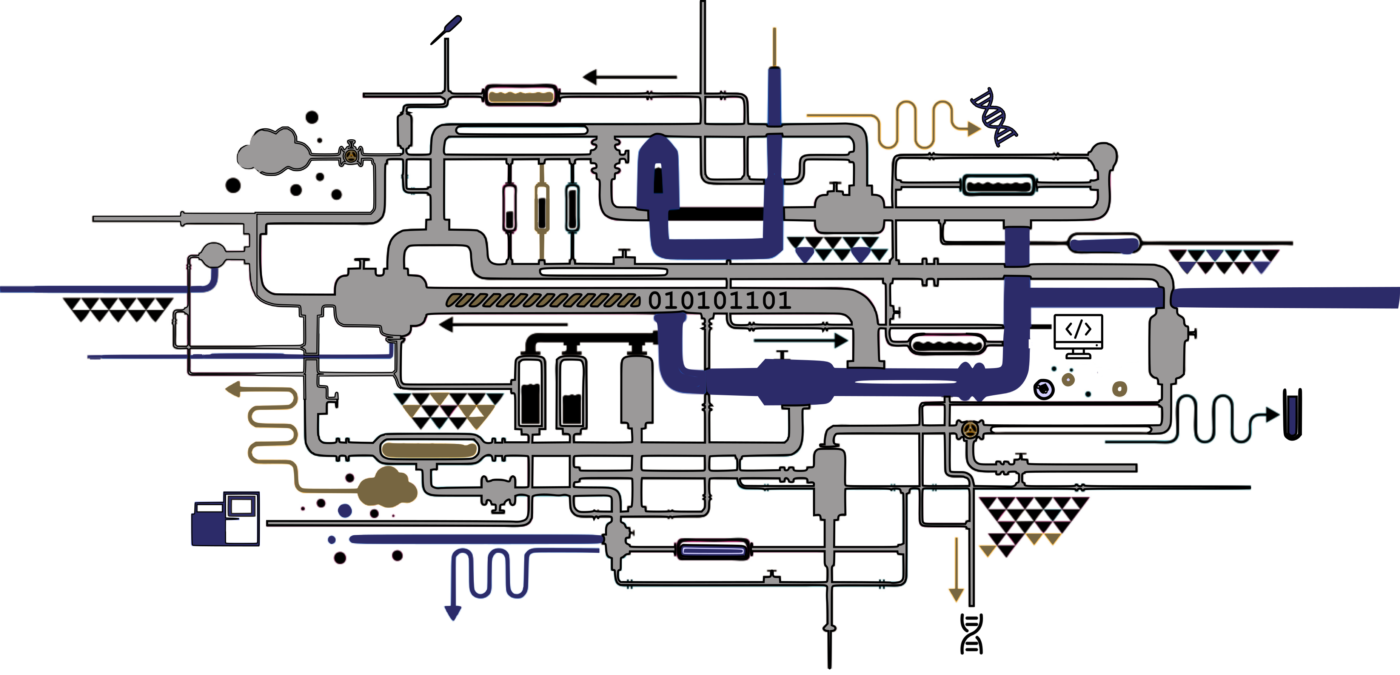
The Bioinformatics and Applied Genomics Unit (BiGen) develops molecular, genomics and bioinformatics applications relevant to sequencing technologies of all generations, but also develops software and pipelines for the analysis of large-scale datasets (big-data). Serving as a Core Facility, BiGen supports all research groups within HPI providing sequencing services, including the design and the execution of wet-lab assay preparation, the sequencing analysis and the downstream bioinformatics. Equipped with high-end sequencers and state of the art robotics, BiGen Unit also provides public services, both in academia and the pharmaceutical industry.

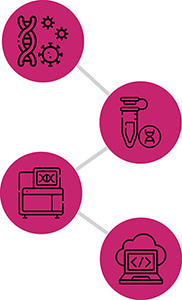
NGS Library Preparations
BiGen runs both ready-to-use and custom NGS assays:
- Total DNA and RNA extraction and purification for NGS applications
- Ribodepletion / poly-A enrichment / globin removal / DNase treatment
- Whole Genome Sequencing (WGS) for viruses, bacteria, fungi, parasites, animals
- Whole Exome Sequencing (WES) both target-enrichment- and amplicon-based
- Custom Target Enrichment panels for regions of interest, from any WGS library preparation
- Targeted gene panels (Comprehensive Cancer, Pharmacogenomics, Inherited disease etc)
- Whole transcriptome, 3’quantseq and single cell RNAseq
- 16S metagenomics
- Whole genome bisulfite sequencing (WGBS)
- Assay for Transposase-Accessible Chromatin (ATAC-seq) and single cell ATAC-seq
- Chromatin immunoprecipitation sequencing (ChIP-seq)
Sequencing technologies
- 1st generation – Sanger sequencing on a compact SeqStudio genetic analyser
- 2nd generation – NGS on Ion Torrent S5 (Thermo), NextSeq2000 and iSeq100 Illumina platforms (single-end or paired-end short read sequencing)
- 3rd generation – NGS on MinION (Oxford Nanopore Technologies) with single-end 1-D or 2-D ultra-long reads both on standard and low throughput flowcells
Bioinformatics
The BiGen group constantly updates the available bioinformatics options, with extensive benchmarking and performance assessments of new tools and utilities. Every analysis step is cross-checked by the use of appropriate internal controls ensuring the validity of the results.
Key bioinformatics pipelines:
- Whole genome reconstruction, de novo assembly and functional annotation (WGS)
- Whole Genome Single Nucleotide Polymorphisms (SNPs) calling and functional annotation
- Whole Genome large-scale structural variations calling and functional annotation
- Genome Wide Association Studies (GWAS)
- RNAseq: Differential gene expression analysis, Gene Ontologies enrichment analysis and clustering
- Single-cell RNAseq: Quality control, clustering, marker detection, cell annotation, differential expression analysis, trajectory analysis
- Metagenomics and Metaviromics, microbiome enrichment analysis
- Genome-wide DNA methylation patterns recognition and profiles comparison
- ATAC-seq peak calling, peak differential analysis and annotation, motif enrichment, footprinting, and nucleosome position analysis
- Genome wide double stranded DNA Breaks Labeling In Situ and Sequencing (BLISS)
- Epidemiology: Phylogenetics, phylogenomics, phylodynamics, phylogeography
BiGen is equipped with state-of-the-art sequencing platforms with complimentary characteristics, providing maximum flexibility in designing NGS experiments of any technology and throughput.
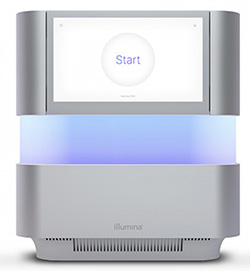
The Illumina NextSeq 2000 Sequencing System takes advantage of an integrated cartridge that includes reagents, fluidics, and the waste holder, simplifying library loading and instrument use. It supports mid-to-high-throughput sequencing applications generating from 100 million up to 2.4 billion reads (30-360Gb), while offering flexibility in multiplexing and after-market reagents compatibility. It is suitable for a broad range of methods such as exome sequencing, target enrichment, single-cell profiling, transcriptome sequencing, epigenomics, etc.
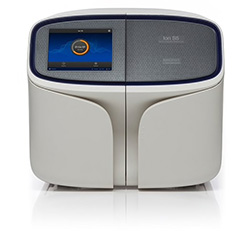
The Ion S5 next-generation sequencing system (ThermoFisher Scientific) leverages the speed of semiconductor sequencing to enable the production of high-quality sequencing data in as little as 2.5 hours. The Ion S5 is accompanied by the Ion OneTouch 2 System which performs template amplification and enrichment. The Ion S5 System is simple to use with cartridge-based reagents and offers superior scalability and flexibility to support a broad range of mid-throughput (0.6 – 30Gb) sequencing applications such as targeted gene panel sequencing, pathogens WGS etc.
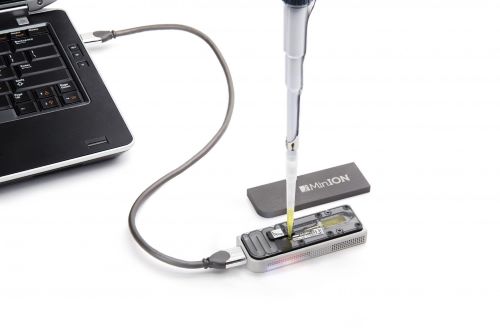
The MinION Next Generation Sequencer (Oxford Nanopore Technologies) is a low throughput platform but can now generate as much as 30 Gb of DNA sequence data or 7-12 million reads. Ultra-long read lengths are possible (hundreds of kb), making it suitable for structural genomics applications. The MinION streams data in real time so that analysis can be performed during the experiment.
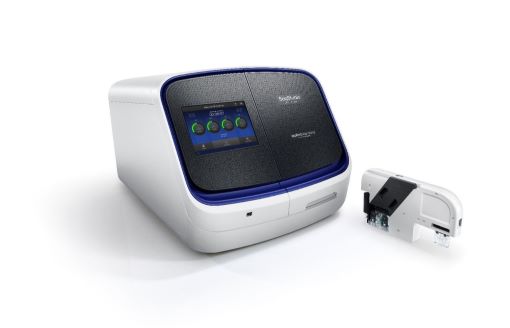
The SeqStudio Genetic Analyzer (Applied Biosystems) is a compact, 4-capillary, fluorescence-based capillary electrophoresis system (Sanger), that utilises an all-in-one reagent cartridge and provides the flexibility to perform both sequencing and fragment analysis in a single run.
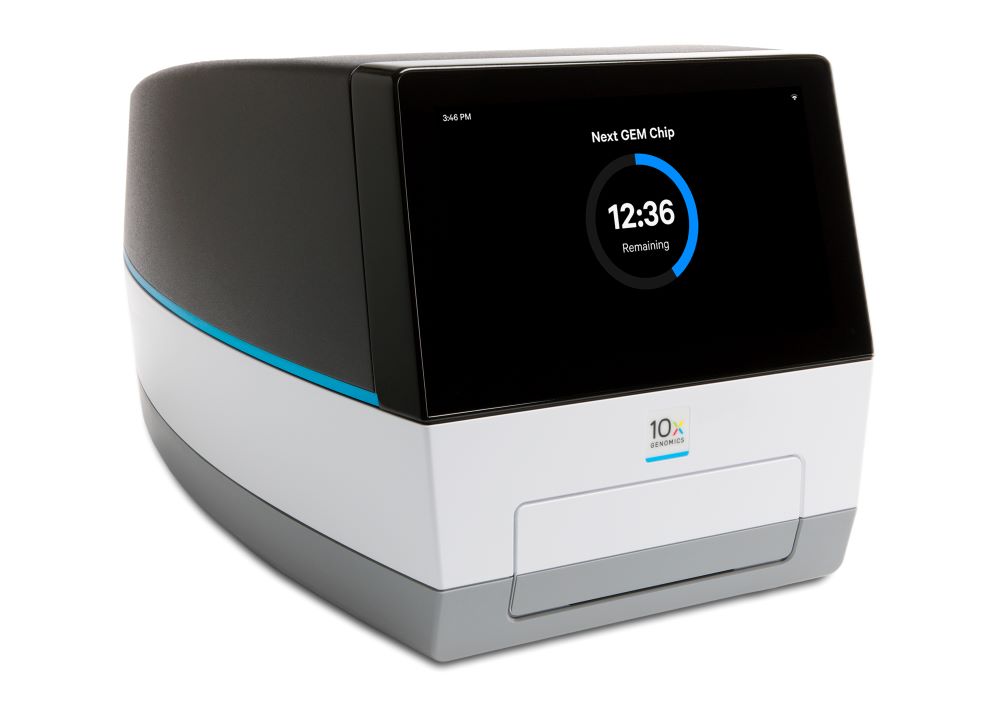
The 10x Chromium X uses advanced microfluidics to perform single cell partitioning and barcoding in a matter of minutes. The Chromium X enables integrated analysis of single cells at massive scale by capturing molecular readouts of cell activity in multiple dimensions, including gene expression, cell surface proteins, immune clonotype, antigen specificity, and chromatin accessibility. Our platform also supports the addition of Feature Barcode Technology (FLEX) which enables sample multiplexing to increase throughput and workflow efficiency.

The quality control of the templates and the libraries is performed with a 2100 Bioanalyzer system which is an established automated electrophoresis tool. The 2100 Bioanalyzer instrument, together with the 2100 Expert Software, provide highly precise analytical evaluation of various sample types in many workflows. Starting from minimal sample volumes, digital data is provided in a timely manner and delivers objective assessment of sizing, quantitation, integrity and purity from DNA, RNA, and proteins.
Quantitative assessment of the libraries is also performed with the Qubit 4 Fluorometer (Invitrogen). Qubit 4 is designed to accurately measure DNA, RNA, and protein quantity. Qubit 4 also easily measures RNA integrity and quality.
The QIAxcel Advanced system is another platform that can be used for quality control purposes as it performs fully automated separation of DNA and RNA fragments according to their molecular weight and can be applied for the determination of the size and concentration of DNA fragments and of the 28S/18S ratio, concentration, and quality of total RNA, and the quality of cRNA/cDNA and fragmented RNA/DNA.
BiGen has a dedicated bioinformatics office with 4 high performance Linux workstations as terminals and a central High-Performance Computing (HPC) Server with updated bioinformatics software and pipelines already in place. The HPI server is accessible remotely and is administrated and serviced by experienced IT personnel who are responsible for their constant availability. On-demand software can be rapidly installed and developed pipelines can seamlessly run, without restriction in the allocation of computing resources. The HPI server and the sequencers are connected to a NAS system in RAID5 configuration for additional storage and backup space. Additional computing power and storage space are provided by the HYPATIA Cloud infrastructure of ELIXIR-GR, via 24/7 VMs and storage volumes.
|
Project Title |
Funding source |
Period |
|
Integrating Multi-Disciplinary Expertise in a Learning and Adaptive European Pandemic Preparedness (LEAPS) |
«HORIZON Research and Innovation Actions» HORIZON-HLTH-2022-DISEASE-07-02 |
2023 - 2027 |
|
«SUB3. Applied Research for Precision Medicine through a Non-Profit Organisation under Private Law - "Hellenic Precision Medicine Network " (HPMN)» |
National Recovery and Resilience Plan “Greece 2.0” (MIS)5184864 |
2023 - 2025 |
|
Decision making support infrastructure for fighting antimicrobial resistant bacteria in hospitals |
National Recovery and Resilience Plan “Greece 2.0” (ΤΑ 5149205) |
2022 - 2024 |
|
Uncovering hidden antimicrobial resistance reservoirs and dynamics in the gut microbiota of undersampled human populations |
International Pasteur Network Programmes Transversaux de Recherche - PTR 2022
|
2022 - 2024 |
|
Subproject 4 of the National Flagship Action entitled “Epidemiological (…), in response to the SARS-CoV-2 crisis” |
Ministry of Development & Investments, Public Investments Programme (PIP) |
2021 - 2023 |
|
«Development of a novel Diagnostics method (…) 3rd generation sequencing technologies » |
Ministry of Development and Investment (5050220) |
2020 - 2022 |
|
«Development of Novel biological products and services for infectious and neurodegenerative diseases» |
Stavros Niarchos Foundation GR (92.38.0002) |
2017 - 2019 |
- Regional Operational Program "Attica 2014-2020": High Technology Infrastructure for Preclinical Studies and Provision of Specialized Services for Infectious and Neurodegenerative Diseases

Bousali M, Pogka V, Vatsellas G, Loupis T, Athanasiadis EI, Zoi K, Thanos D, Paraskevis D, Mentis A, Karamitros T. Tracing the First Days of the SARS-CoV-2 Pandemic in Greece and the Role of the First Imported Group of Travelers. Microbiol Spectr. 2022 Dec 21;10(6):e0213422. doi: 10.1128/spectrum.02134-22. Epub 2022 Nov 21. PMID: 36409093
Pogka V, Papadopoulou G, Valiakou V, Sgouras DN, Mentis AF, Karamitros T. Targeted Virome Sequencing Enhances Unbiased Detection and Genome Assembly of Known and Emerging Viruses-The Example of SARS-CoV-2. Viruses. 2022 Jun 11;14(6):1272. doi: 10.3390/v14061272.
Zampetidis CP, Galanos P, Angelopoulou A, Zhu Y, Polyzou A, Karamitros T, Kotsinas A, Lagopati N, Mourkioti I, Mirzazadeh R, Polyzos A, Garnerone S, Mizi A, Gusmao EG, Sofiadis K, Gál Z, Larsen DH, Pefani DE, Demaria M, Tsirigos A, Crosetto N, Maya-Mendoza A, Papaspyropoulos A, Evangelou K, Bartek J, Papantonis A, Gorgoulis VG. A recurrent chromosomal inversion suffices for driving escape from oncogene-induced senescence via subTAD reorganization. Mol Cell. 2021 Dec 2;81(23):4907-4923.e8. doi: 10.1016/j.molcel.2021.10.017. Epub 2021 Nov 17. PMID: 34793711
Bousali M, Papatheodoridis G, Paraskevis D, Karamitros T. Hepatitis B Virus DNA Integration, Chronic Infections and Hepatocellular Carcinoma. Microorganisms. 2021 Aug 23;9(8):1787. doi: 10.3390/microorganisms9081787.
Karamitros T, Pogka V, Papadopoulou G, Tsitsilonis O, Evangelidou M, Sympardi S, Mentis A. Dual RNA-Seq Enables Full-Genome Assembly of Measles Virus and Characterization of Host-Pathogen Interactions. Microorganisms. 2021 Jul 20;9(7):1538. doi: 10.3390/microorganisms9071538.
Bousali M, Dimadi A, Kostaki EG, Tsiodras S, Nikolopoulos GK, Sgouras DN, Magiorkinis G, Papatheodoridis G, Pogka V, Lourida G, Argyraki A, Angelakis E, Sourvinos G, Beloukas A, Paraskevis D, Karamitros T. SARS-CoV-2 Molecular Transmission Clusters and Containment Measures in Ten European Regions during the First Pandemic Wave. Life (Basel). 2021 Mar 9;11(3):219. doi: 10.3390/life11030219.
Kontizas E, Tastsoglou S, Karamitros T, Karayiannis Y, Kollia P, Hatzigeorgiou AG, Sgouras DN. Impact of Helicobacter pylori Infection and Its Major Virulence Factor CagA on DNA Damage Repair. Microorganisms. 2020 Dec 16;8(12):2007. doi: 10.3390/microorganisms8122007.
Pogka V, Horefti E, Evangelidou M, Kostaki EG, Paraskevis D, Flountzi A, Georgakopoulou T, Magaziotou I, Mentis A, Karamitros T. Spatiotemporal Distribution and Genetic Characterization of Measles Strains Circulating in Greece during the 2017-2018 Outbreak. Viruses. 2020 Oct 15;12(10):1166. doi: 10.3390/v12101166.
Bastard P, Rosen LB, Zhang Q, Michailidis E, Hoffmann HH, […], COVID Human Genetic Effort […]. Autoantibodies against type I IFNs in patients with life-threatening COVID-19. Science. 2020 Oct 23;370(6515):eabd4585. doi: 10.1126/science.abd4585. Epub 2020 Sep 24.
Zhang Q, Bastard P, Liu Z, Le Pen J, Moncada-Velez M, […], COVID Human Genetic Effort, […]. Inborn errors of type I IFN immunity in patients with life-threatening COVID-19. Science. 2020 Oct 23;370(6515):eabd4570. doi: 10.1126/science.abd4570. Epub 2020 Sep 24.
Karamitros T, Papadopoulou G, Bousali M, Mexias A, Tsiodras S, Mentis A. SARS-CoV-2 exhibits intra-host genomic plasticity and low-frequency polymorphic quasispecies. J Clin Virol. 2020 Oct;131:104585. doi: 10.1016/j.jcv.2020.104585. Epub 2020 Aug 11.
Harakeh S, Angelakis E, Karamitros T, Bachar D, Bahijri S, Ajabnoor G, Alfadul SM, Farraj SA, Al Amri T, Al-Hejin A, Ahmed A, Mirza AA, Didier R, Azhar EI. Impact of smoking cessation, coffee and bread consumption on the intestinal microbial composition among Saudis: A cross-sectional study. PLoS One. 2020 Apr 29;15(4):e0230895. doi: 10.1371/journal.pone.0230895.
Hurst TP, Aswad A, Karamitros T, Katzourakis A, Smith AL, Magiorkinis G. Interferon-Inducible Protein 16 (IFI16) Has a Broad-Spectrum Binding Ability Against ssDNA Targets: An Evolutionary Hypothesis for Antiretroviral Checkpoint. Front Microbiol. 2019 Jul 4;10:1426. doi: 10.3389/fmicb.2019.01426.
Karamichali E, Chihab H, Kakkanas A, Marchio A, Karamitros T, Pogka V, Varaklioti A, Kalliaropoulos A, Martinez-Gonzales B, Foka P, Koskinas I, Mentis A, Benjelloun S, Pineau P, Georgopoulou U. HCV Defective Genomes Promote Persistent Infection by Modulating the Viral Life Cycle. Front Microbiol. 2018 Dec 3;9:2942. doi: 10.3389/fmicb.2018.02942.
Karamitros T, Hurst T, Marchi E, Karamichali E, Georgopoulou U, Mentis A, Riepsaame J, Lin A, Paraskevis D, Hatzakis A, McLauchlan J, Katzourakis A, Magiorkinis G. Human Endogenous Retrovirus-K HML-2 integration within RASGRF2 is associated with intravenous drug abuse and modulates transcription in a cell-line model. Proc Natl Acad Sci U S A. 2018 Oct 9;115(41):10434-10439. doi: 10.1073/pnas.1811940115. Epub 2018 Sep 24.
Karamitros T, van Wilgenburg B, Wills M, Klenerman P, Magiorkinis G. Nanopore sequencing and full genome de novo assembly of human cytomegalovirus TB40/E reveals clonal diversity and structural variations. BMC Genomics. 2018 Aug 2;19(1):577. doi: 10.1186/s12864-018-4949-6.
Karamitros T, Papatheodoridis G, Paraskevis D, Hatzakis A, Mbisa JL, Georgopoulou U, Klenerman P, Magiorkinis G. Impact of Interferon-α Receptor-1 Promoter Polymorphisms on the Transcriptome of the Hepatitis B Virus-Associated Hepatocellular Carcinoma. Front Immunol. 2018 Apr 16;9:777. doi: 10.3389/fimmu.2018.00777.
Kostaki EG, Karamitros T, Stefanou G, Mamais I, Angelis K, Hatzakis A, Kramvis A, Paraskevis D. Unravelling the history of hepatitis B virus genotypes A and D infection using a full-genome phylogenetic and phylogeographic approach. Elife. 2018 Aug 7;7:e36709. doi: 10.7554/eLife.36709.
Kostaki EG, Karamitros T, Bobkova M, Oikonomopoulou M, Magiorkinis G, Garcia F, Hatzakis A, Paraskevis D. Spatiotemporal Characteristics of the HIV-1 CRF02_AG/CRF63_02A1 Epidemic in Russia and Central Asia. AIDS Res Hum Retroviruses. 2018 May;34(5):415-420. doi: 10.1089/AID.2017.0233. Epub 2018 Apr 5.
Karamitros T, Papatheodoridis G, Paraskevis D, Hatzakis A, Mbisa JL,Georgopoulou U, Klenerman P, Magiorkinis G. Impact of Interferon-α Receptor-1 Promoter Polymorphisms on the Transcriptome of the Hepatitis B Virus-Associated Hepatocellular Carcinoma. Front Immunol. 2018 Apr 16;9:777. doi: 10.3389/fimmu.2018.00777.
Santander CG, Gambron P, Marchi E, Karamitros T, Katzourakis A, Magiorkinis G. STEAK: A specific tool for transposable elements and retrovirus detection in high-throughput sequencing data. Virus Evol. 2017 Aug 21;3(2):vex023. doi: 10.1093/ve/vex023.
Karamitros T, Paraskevis D, Hatzakis A, Psichogiou M, Elefsiniotis I, Hurst T, Geretti AM, Beloukas A, Frater J, Klenerman P, Katzourakis A, Magiorkinis G. A contaminant-free assessment of Endogenous Retroviral RNA in human plasma. SciRep. 2016 Sep 19;6:33598. doi: 10.1038/srep33598.
Karamitros T, Harrison I, Piorkowska R, Katzourakis A, Magiorkinis G, Mbisa JL. De Novo Assembly of Human Herpes Virus Type 1 (HHV-1) Genome, Mining of Non- Canonical Structures and Detection of Novel Drug-Resistance Mutations Using Short- and Long-Read Next Generation Sequencing Technologies. PLoS One. 2016 Jun 16;11(6):e0157600. doi: 10.1371/journal.pone.0157600.
Karamitros T, Magiorkinis G. A novel method for the multiplexed target enrichment of MinION next generation sequencing libraries using PCR-generated baits. Nucleic Acids Res. 2015 Dec 15;43(22):e152. doi: 10.1093/nar/gkv773. Epub 2015 Aug 3.
